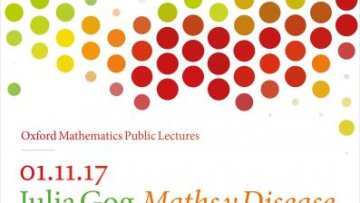We have an exciting series of Oxford Mathematics Public Lectures this Autumn. Summary below and full details here. All will be podcast and on Facebook Live. We also have a London Lecture by Andrew Wiles on 28 November (details will follow separately). Please email @email to register for the lectures below.
14:30
Peter Sarnak - Integer points on affine cubic surfaces
Abstract
A cubic polynomial equation in four or more variables tends to have many integer solutions, while one in two variables has a limited number of such solutions. There is a body of work establishing results along these lines. On the other hand very little is known in the critical case of three variables. For special such cubics, which we call Markoff surfaces, a theory can be developed. We will review some of the tools used to deal with these and related problems.
Joint works with Bourgain/Gamburd and with Ghosh
15:00
Adaptive Oblivious Transfer with Access Control from Lattice Assumptions
Abstract
Adaptive oblivious transfer (OT) is a protocol where a sender
initially commits to a database {M_i}_{i=1}^N . Then, a receiver can query the
sender up to k times with private indexes ρ_1, …, ρ_k so as to obtain
M_{ρ_1}, …, M_{ρ_k} and nothing else. Moreover, for each i ∈ [k], the receiver’s
choice ρ_i may depend on previously obtained messages {M_ρ_j}_{j<i} . Oblivious transfer
with access control (OT-AC) is a flavor of adaptive OT
where database records are protected by distinct access control policies
that specify which credentials a receiver should obtain in order to access
each M_i . So far, all known OT-AC protocols only support access policies
made of conjunctions or rely on ad hoc assumptions in pairing-friendly
groups (or both). In this paper, we provide an OT-AC protocol where access policies may consist of any branching program of polynomial length, which is sufficient to realize any access policy in NC^1. The security of
our protocol is proved under the Learning-with-Errors (LWE) and Short-
Integer-Solution (SIS) assumptions. As a result of independent interest,
we provide protocols for proving the correct evaluation of a committed
branching program on a committed input.
Joint work with Benoît Libert, San Ling, Khoa Nguyen and Huaxiong Wang.
Bacterial flows
Abstract
Most motile bacteria are equipped with multiple helical flagella, slender appendages whose rotation in viscous fluids allow the cells to self-propel. We highlight in this talk two consequences of hydrodynamics for bacteria. We first show how the swimming of cells with multiple flagella is enabled by an elastohydrodynamic instability. We next demonstrate how interactions between flagellar filaments mediated by the fluid govern the ability of the cells to reorient.
Stochasticity and robustness in morphogenesis
Abstract
How do organisms cope with cellular variability to achieve well-defined morphologies and architectures? We are addressing this question by combining experiments with live plants and analyses of (stochastic) models that integrate cell-cell communication and tissue mechanics. During the talk, I will survey our results concerning plant architecture (phyllotaxis) and organ morphogenesis.
Cascade dynamics on networks
Abstract
Network models may be applied to describe many complex systems, and in the era of online social networks the study of dynamics on networks is an important branch of computational social science. Cascade dynamics can occur when the state of a node is affected by the states of its neighbours in the network, for example when a Twitter user is inspired to retweet a message that she received from a user she follows, with one event (the retweet) potentially causing further events (retweets by followers of followers) in a chain reaction. In this talk I will review some simple models that can help us understand how social contagion (the spread of cultural fads and the viral diffusion of information) depends upon the structure of the social network and on the dynamics of human behaviour. Although the models are simple enough to allow for mathematical analysis, I will show examples where they can also provide good matches to empirical observations of cascades on social networks.
Morse inequalities for arbitrary smooth functions
Abstract
A Morse function (and more generally a Morse-Bott function) on a compact manifold M has associated Morse inequalities. The aim of this
talk is to explain how we can associate Morse inequalities to any smooth function on M (reporting on work of/with G Penington).
16:00
Heights and anabelian geometry
Abstract
For a smooth variety over a number field, one defines various different homology groups (Betti, de Rham, etale, log-crystalline), which carry various kinds of enriching structure and are thought of as a system of realisations for a putative underlying (mixed) motivic homology group. Following Deligne, one can study fundamental groups in the same way, and the study of specific realisations of the motivic fundamental group has already found Diophantine applications, for instance in the anabelian proof of Siegel's theorem by Kim.
It is hoped that study of fundamental groups should give one access to ``higher'' arithmetic information not visible in the first cohomology, for instance classical and p-adic heights. In this talk, we will discuss recent work making this hope concrete, by demonstrating how local components of canonical heights on abelian varieties admit a natural description in terms of fundamental groups.



